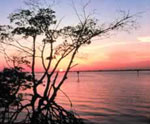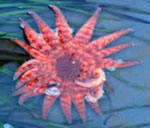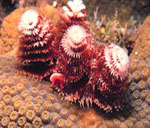You are here: Home › Ecosystems
Ecosystems - Overview
An ecosystem is:
- the dynamic and interrelating complex of plant and animal communities and their associated non-living environment.
- the physical and climactic features and all the living and dead organisms in an area that are interrelated in the transfer of energy and material.
- an interacting complex of a community and its environment functioning as an ecological unit in nature, requiring assumptions of energetics, ecological interactions, and species adaptations.
The geographic scope of NCCOS' research encompasses coastal watersheds to the outer boundary of the U.S. Exclusive Economic Zone (EEZ), 200 miles offshore the U.S. coast.
Because of the breadth of this research area, NCCOS focuses primarily on those ecosystems managed directly and indirectly by NOAA. These ecosystems include coastal estuaries, including the National Estuarine Research Reserves; National Marine Sanctuaries; and coral reef ecosystems.

Coastal Oceans
The coastal ocean encompasses a broad range of saltwater ecosystems, including estuaries, coral reefs, rocky shores, gravel shores, sandy shores, mud flats, marshes, and mangrove forests. These ecosystems exist where streams and rivers meet the sea and where tides and coastal currents mix. Learn more ›
Coral Reefs 
U.S. coral reef ecosystems are complex resources that contribute to biological diversity, fisheries production, coastal protection, tourism, maritime and cultural heritage, and human sustenance. Coral reef ecosystems are under stress from both natural events (e.g., hurricanes and tropical storms) and human activities (e.g., tourism, fishing, and dredging). Symptoms such as decreases in hard coral covers, proliferation of algae, increases in coral bleaching, and disease outbreaks indicate that almost 60 percent of the world's reefs and the resources they support are at risk. NCCOS is working to meet the national goal of reversing the degradation of U.S. coral reef ecosystems. Learn more ›
Estuaries

Estuaries make up approximately 10,900,000 hectares of the U.S. coastline. An estuary is a semi-enclosed coastal body of water that has a measurable salinity gradient from its freshwater drainage to its ocean entrance. Bay and estuarine systems are among the most productive ecosystems on Earth; however, for a variety of different reasons, many estuarine systems are experiencing a decline in productivity. NCCOS is currently determining the status of the nation's estuaries, understand the factors involved in any decline, and develop methodologies for restoring estuarine habitats. Learn more ›
National Marine Sanctuaries

National Marine Sanctuaries are areas that have been set aside for a variety of different reasons and provide differing levels of protection. These National Marine Sanctuaries include everything from the breeding and feeding grounds of marine animals - including whales, sea lions, sharks, and sea turtles - to significant coral reefs and kelp forest habitats, and the remains of the U.S. Monitor (a Civil War ironclad sunk off the coast of North Carolina). There are currently 13 National Marine Sanctuaries and one coral reef ecosytem reserve found in both the Pacific and Atlantic Oceans and in the Great Lakes. Sanctuaries are managed for a variety of objectives, including maintaining the integrity of their unique natural and cultural resources while still allowing compatible recreational and commercial activities. NCCOS is working with the different National Marine Sanctuaries to determine the overall status of the Sanctuaries, the effectiveness of the Sanctuaries in achieving their objectives, and the possible effects of alternative management actions on Sanctuary ecosystems. Learn more ›



